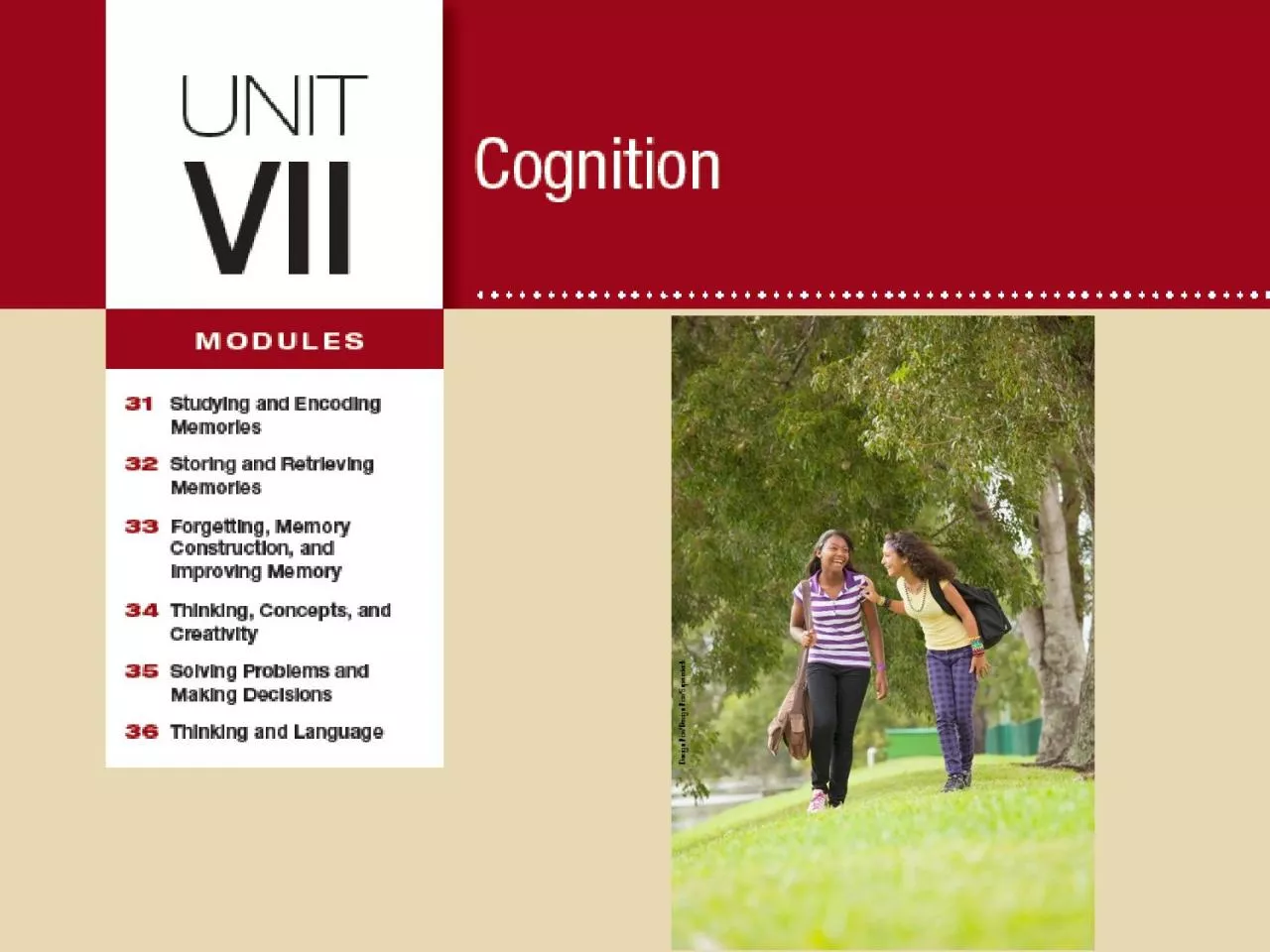

Thinking Concepts and Creativity Learning Targets 341 Define cognition and describe the functions of concepts 342 Discuss the factors associated with creativity and describe some ways of fostering creativity ID: 1019470
Download Presentation The PPT/PDF document "Unit 7 Cognition Module 34" is the property of its rightful owner. Permission is granted to download and print the materials on this web site for personal, non-commercial use only, and to display it on your personal computer provided you do not modify the materials and that you retain all copyright notices contained in the materials. By downloading content from our website, you accept the terms of this agreement.
1. Unit 7Cognition
2. Module 34Thinking, Concepts, and CreativityLearning Targets34-1 Define cognition, and describe the functions of concepts.34-2 Discuss the factors associated with creativity, and describe some ways of fostering creativity.
3. What is cognition?all the mentalactivities associated with thinking,knowing, remembering, andcommunicating
4. conceptsmental groupings of similar objects, events, ideas, orPeopleEx: chairs, boats, trucks
5. prototypea mental image or best example of a categoryEx: specific car, boat, tree, birdWhile chairs can come in all shapes and sizes, modern models and antique creations, the basic four-legged, chair with a back often serves as the prototype for ‘chair’. EPCOT?
6. Can you think of examples?conceptWhat examples could be included in the concept ‘bird’?prototypeWhat is the best example of ‘bird’? What is the ‘birdiest bird’?Does the prototype change if you live in New York City? Miami, Florida?
7. 1. What Would You Answer?When asked to think of a dog, many people think of a golden retriever. In this case a golden retriever is people’s _________ for a dog.A. prototypeB. conceptC. déjà vuD. morphemeE. heuristic
8. How do prototypes help form concepts? Matching new items to a prototype providesa quick and easy method for sorting items into categories (or concepts).Concepts help us understand our world.
9. How do we categorize people?When we categorize people, we mentally shift them toward our category prototypes.
10. What research has been conducted?When Belgian students viewed a blended face in which 70 percent of the features were Caucasian and 30 percent were Asian, the students categorized the face as Caucasian.
11. What were the results?Likewise, if shown a 70 percent Asian face, the students later remembered a more prototypically Asian face.Corneille et al., 2004
12. Into which category (concept) would you put the following items?Is a tomato a fruit or a vegetable?Is a whale a fish or a mammal?Is a 16-year old female a girl or a woman?
13. What happens when events, people or items do not match our prototypes?When symptoms don’t fit one of our disease prototypes, we are slow to perceive an illness.(Bishop, 1991)People whose heart attack symptoms (shortness of breath, exhaustion, a dull weight in the chest) don’t match their heart attack prototype (sharp chest pain) may not seek help.When behaviors don’t fit our discrimination prototypes—of White against Black, male against female, young against old—we often fail to notice prejudice.
14. What is creativity and what are two kinds of thinking?Creativity is the ability to produce new (novel) and valuable (useful) ideas.convergent thinkingnarrowingthe available problem solutions todetermine the single best solutionEx: deductive logic used by Sherlock Holmesdivergent thinkingexpandingthe number of possible problem solutions; creative thinking thatexpands in different directionsEx: developing new ideas and theories
15.
16. What are some examples?convergent thinkingAptitude tests (such as the SAT) typically require convergent thinking—an ability to provide a single correct answer.divergent thinkingCreativity tests (How many uses can you think of for a brick?) require divergentthinking—the ability to consider many different options and to think in novel ways.
17. Practice your divergent thinking.How many uses can you create for a paper cup?How many different ways can you use a brick?Compare your lists with a partner.
18. What are the five components of creativity according to Robert Sternberg?expertiseimaginative thinking skillsa venturesome personalityintrinsic motivationa creative environment
19. What is a venturesome personality?A venturesome personality seeks new experiences,tolerates ambiguity and risk, and perseveresin overcoming obstacles. Princeton mathematician Andrew Wiles pondered for more than 30 years, a mathematical puzzle left by Pierre de Fermat, a seventeenth-century mischievous mathematical genius. Wiles said he labored in near-isolation from the mathematics community partly to stay focused and avoid distraction.
20. What is imaginative thinking?Cartoonistsoften display creativity as they see things in new ways or make unusualconnections.
21. How to boost your creativity…Develop your expertise.Allow time for incubation (think hard on a problem, then set it aside and come back to it later).Set aside time for the mind to roam freely. Experience other cultures and ways of thinking.
22. 2. What Would You Answer?Mental activities associated with remembering, thinking, and knowing are calledA. cognition.B. concepts.C. prototypes.D. convergent thinking.E. divergent thinking.
23. Learning Target 34-1 ReviewDefine cognition, and describe the functions of concepts.Cognition refers to all the mental activities associated with thinking, knowing, remembering, and communicating.We use concepts, mental groupings of similar objects, events, ideas, or people, to simplify and order the world around us.We form most concepts around prototypes, or best examples of a category.
24. Learning Target 34-2 ReviewDiscuss the factors associated with creativity, and describe some ways of fostering creativity.Creativity, the ability to produce novel and valuable ideas, is supported by a certain level of aptitude. But whereas aptitude tests require convergent thinking, creativity tests require divergent thinking.Sternberg has proposed that creativity has five components: expertise, imaginative thinking skills; a venturesome personality; intrinsic motivation; and a creative environment that sparks, supports, and refines creative ideas.